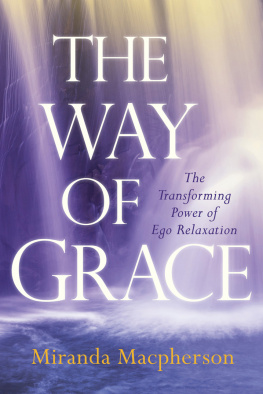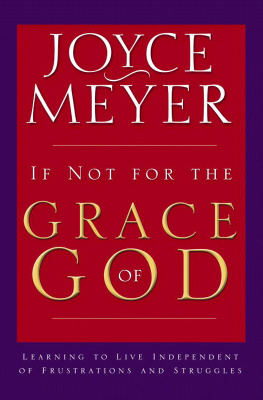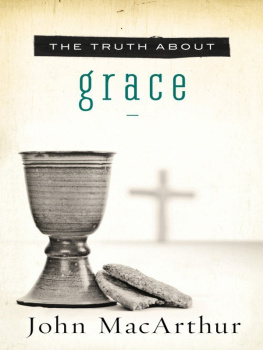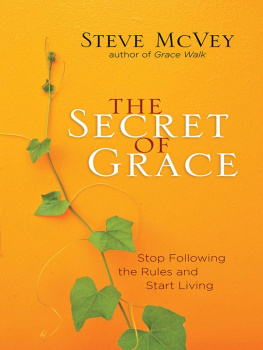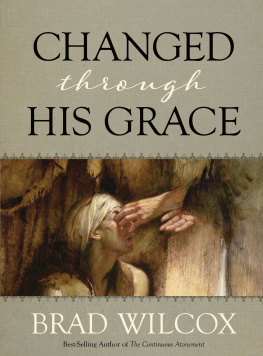
For God,
for my students,
and for you, dear reader

CONTENTS
by Russ Hudson
FOREWORD
G race. It is such a simple and beautiful worda word that tends to lighten our mood and inspire us when we hear it. Regardless of our spiritual background, and even if we have not been much interested in spirituality as such, we can recognize something that has been here all along, in the background of our awareness, and arising more explicitly in our transitions and transformations. When we stop to consider it, we generally have some personal sense of being touched by grace. Yet to what, exactly, does this word refer?
Grace is not a thing. It is not something we can touch, although we may feel touched by it. It is not something we can see, although we may very well see the effects of Grace on ourselves and others. It is not something that we can hear, yet we may feel called by it. And it is not something we can taste, yet there is some particular sense to it, and some tastes may remind us of its presence.
Further, Grace is not an emotion, although it may produce many emotionseven profound states of feeling. It is not a thought, though when we have experienced it, we are likely to have a lot of thoughts about it! It is not a sensation, although the action of Grace may well produce many sensations in our body. We begin to realize that what we are seeking to understand is beyond the usual categories of objects and sensory experiences by which we usually navigate the world. To find the realm of Grace, we need to look deeper.
Clearly, as with all the most important inner elements of being a human being, Grace is something subtle, and found in the deepest places in our hearts, in the very fabric of our consciousness. Its presence is unmistakableand we do indeed learn to recognize the sensory signals that let us know we are in the proximity of this mystery. And even then, it takes a long time to really understand how to dance with this inner partnerhow to surrender to its profound and astonishing influence.
In this book, Miranda Macpherson helps us come closer to understanding this mystery by breaking it down into four aspects or components. First, she shows us that Grace is a way of experiencing the ground of our humanitythe very foundation of our consciousness. In the traditions behind the Enneagram and the work that I do, we call this our essence. While it is interesting to talk about essence and to seek some way of defining it, it is best understood experientially, and Miranda guides us into inquiries, meditations, and practices that will do just that. We come to recognize a deeper layer of our Self that is here as background, regardless of whatever else we may be experiencing. Further, it is contact with these deeper dimensions of our experience that produce real and lasting change in us, as we will see.
Second, The Way of Grace shows us the tremendous blessings and benefit that come from contact with our essential nature. It is a huge relief when we discover the gentle and expansive qualities of our essential being. It holds our difficulties with patience, compassion, and loving kindness, and we learn to trust that this inner fountain of benevolence is always available. We merely forget its existence in the daily preoccupations of our ego and its agendas. Yet in a breath, a pause, a single moment when we are willing to notice and sense into the deeper layers of our being, this miraculous quality of blessing is always present, waiting for us.
Thirdly, Miranda helps us see that it is this blessing of Grace that actually transforms us, both psychologically and spiritually. To understand this, it is useful to think of our Self as being a dynamic relationship between our usual sense of selfwhat is commonly called our ego consciousnessand the deeper ground of essence of which we were just speaking. We learn that Grace is not a bypass of our egoic life and its attendant suffering; rather, Grace brings light and compassion to our pain and difficulties and actually transmutes them into something useable for our growth. Grace gives us the capacity to be with our experiences so that they can be digested and integrated into our souls greater purpose. There is no spiritual bypass here. We are bringing loving awareness to our distressnot denying its existence. Grace gives us the grounded presence and lightness of heart that lets us stay, even with our historic pain and fear. It is this vital distinction that helps us live the truths we are learning and make them part of our lived lives.
Lastly, the transforming power of Grace helps us live our realization in the worldin our work and in our relationships. As Miranda mentions in this book, realizations can happen in a moment, but learning to integrate them in a way that supports our lived lives takes time and persistence. Many seekers get into trouble thinking that their realization experience marks the end of their journey, while many elements of their suffering remain unhealed. Grace teaches us to slow down, to enjoy the ongoing discoveries and flavors of our existence while growing in our sense of love and service in this world. It teaches us to meet our shame and fear and anger with consciousness and tenderness. We stop berating ourselves for our apparent lack of progress and get interested in what is arising in our consciousness moment by moment.
Really, Grace teaches us to live in two worlds at the same time, and ultimately, to see that they really are one. We learn to embody the essential qualities of our consciousness and discern the meaning of the spiritual advice to be in the world but not of it. We find blessings in the small events of daily lifewe see God in a teacup, and realize that the power of Grace is always right here and right now. We recognize the preciousness of our journey, of our relationships, and of the people who are in our lives, and learn to appreciate every step of our journey as we take it. And we understand this is not a race with a finish line; we will be dancing with Grace and realizations of deeper aspects of ourselves for the rest of our lives. Participating in this ever-deepening and ever-expanding dance is our greatest joy.
If we take in this teaching deeply, we will come to recognize the centrality of learning to surrender. This may sound easy to some, but as we embark on the journey of surrender, we will likely realize that little in our lives has really taught us how to engage this dance. We eventually discover that we do not decide to surrender. If we still think of it as a decision that we can choose or not, we have not yet fully understood what surrender is. We come to see that surrender is not an action we can takeit is really found more in seeing a greater truth. When we open to the deeper dimensions of our experience while we are engaged in the day-to-day challenges of life, we start to see that we are not directing our lives in the way we may have imagined, and that greater forces are at work within us and around us.
Seeing this, something in our soul relaxes. Without exactly deciding to, we let go on a deeper level, and the transforming powers of Grace guide us through the experience to a new sense of ourselves and of life. As we will see in the pages of this book, so much of inner work is really a process of helping our frightened ego patterns to relax into the ground of being and discovering that doing so brings us everything we have been seeking.
We might well wonder what role we play in this process. Clearly, we are not in charge of our own transformationthe ego does not fix the egoand at the same time, we know that passivity is not going to help us much either. What is required? As it turns out, our active attention attracts the action of Grace. We become
Next page
